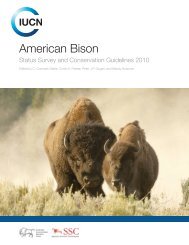Complete mitochondrial DNA sequence analysis of Bison bison and ...
Complete mitochondrial DNA sequence analysis of Bison bison and ...
Complete mitochondrial DNA sequence analysis of Bison bison and ...
You also want an ePaper? Increase the reach of your titles
YUMPU automatically turns print PDFs into web optimized ePapers that Google loves.
Table 3<br />
Predicted changes in tRNA structure between <strong>bison</strong> <strong>and</strong> <strong>bison</strong>–cattle hybrids. Gray-shaded squares indicate the predicted position <strong>of</strong> SNPs in the tRNA structure; black square<br />
indicates SNPs in both loop <strong>and</strong> stem structures.<br />
Order from<br />
Table 1 Gene<br />
Fixed<br />
differences a<br />
1 tRNA-Phe 0 0<br />
3 tRNA-Val 0 0<br />
5 tRNA-Leu 1 1<br />
7 tRNA-Ile 2 0<br />
8 tRNA-Gln 2 0<br />
9 tRNA-Met 2 0<br />
11 tRNA-Trp 0 0<br />
12 tRNA-Ala 0 1<br />
13 tRNA-Asn 6 0<br />
14 tRNA-Cys 1 0<br />
15 tRNA-Tyr 1 0<br />
17 tRNA-Ser 0 3<br />
18 tRNA-Asp 4 0<br />
20 tRNA-Lys 2 0<br />
24 tRNA-Gly 3 0<br />
26 tRNA-Arg 1 0<br />
29 tRNA-His 0 0<br />
30 tRNA-Ser2 4 0<br />
31 tRNA-Leu2 3 0<br />
34 tRNA-Glu 1 0<br />
36 tRNA-Thr 3 0<br />
37 tRNA-Pro 2 0<br />
a<br />
Indicates number <strong>of</strong> fixed differences between <strong>bison</strong> <strong>and</strong> hybrid groups.<br />
b<br />
Indicates number <strong>of</strong> polymorphic sites within <strong>bison</strong>.<br />
roots the <strong>bison</strong> clade (Achilli et al., 2008) <strong>and</strong> is divergent from the<br />
other <strong>bison</strong> haplotypes analyzed in this study (Fig. 4, III). Unfortunately,<br />
this <strong>sequence</strong> was obtained from a <strong>bison</strong> at the Antwerp<br />
Zoo in Belgium that was originally procured through the University<br />
<strong>of</strong> Utrecht with no data indicating ancestral geographical origins<br />
K.C. Douglas et al. / Mitochondrion 11 (2011) 166–175<br />
Polymorphic<br />
dites b D loop/stem TψC loop/Stem Central loop<br />
Anticodon<br />
loop/stem<br />
Acceptor<br />
arm stem<br />
(Antonio Torroni, personal communication). A major sub-clade<br />
(Fig. 4, I) is formed from haplotypes from Fort Niobrara National<br />
Wildlife Refuge (bHap10), Yellowstone National Park (bHap17), the<br />
National <strong>Bison</strong> Range (bHap2), <strong>and</strong> the private <strong>bison</strong> herd. Another<br />
major sub-clade (Fig. 4, II) includes <strong>sequence</strong>s from the Texas State<br />
Fig. 2. <strong>DNA</strong> alignment <strong>and</strong> predicted tRNA secondary structures <strong>of</strong> <strong>bison</strong> <strong>and</strong> <strong>bison</strong>–cattle hybrid haplotypes for tRNA-asparagine (asn). The <strong>DNA</strong> alignment was created in Clustal X<br />
(Larkin et al., 2007) <strong>and</strong> the predicted tRNA secondary structures were created using tRNAscan-SE (Lowe <strong>and</strong> Eddy, 1997). Differences between the <strong>bison</strong> <strong>and</strong> <strong>bison</strong>–cattle hybrid<br />
haplotypes are indicated in bold typeface. An asterisk (*) in the <strong>bison</strong>–cattle hybrid tRNA structure indicates the location <strong>of</strong> the indel (missing A nucleotide).<br />
171










